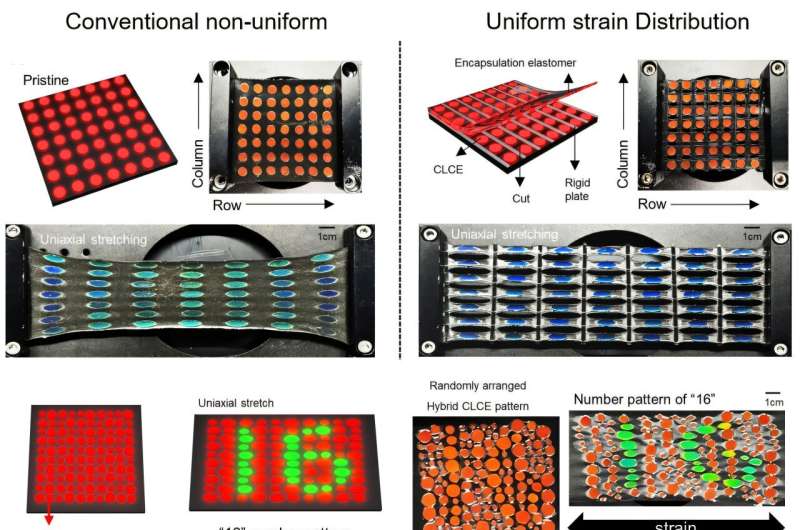
A group of researchers at POSTECH (Pohang University of Science and Technology) has unveiled a groundbreaking technology that allows for consistent stretching across multiple pixels in a stretchable display. This significant achievement resolves a major issue in the industry and has been highlighted on the back cover of the journal Advanced Functional Materials. The project was led by Professor Su Seok Choi from the Department of Electrical Engineering and Ph.D. candidate Jun Hyuk Shin.
The display technology sector is going through a major transformation, with fierce competition in devices that can change shape. Innovations like foldable, bendable, and slidable screens are already on the market, and there’s a growing focus—especially in South Korea—on stretchable displays, which can physically expand rather than just bend.
Future stretchable displays are predicted to evolve into next-gen devices that work with sensors to create electronic systems resembling human skin. For this advancement, technology that allows for intrinsic and uniform stretching is highly sought after.
Shortcomings of Current Stretchable Display Technologies
Many of the existing stretchable technologies use an external approach, connecting rigid electronic parts with wavy or serpentine interconnects. While this permits some mechanical flexibility, there are significant drawbacks—like restricted stretching, diminished performance, and a decline in display consistency and image quality when under strain.
On the other hand, the intrinsic approach employs materials like silicone or rubber that are inherently flexible. Yet, these systems have faced challenges with uneven strain distribution, especially in multi-pixel setups. Each pixel experiences varying levels of deformation based on its position, leading to differences in color, brightness, and signal quality.
This problem stems from fundamental principles of geometry and physics: when stretching a flexible material, areas away from the tension point endure less strain—much like how the middle of a rubber band stretches more than its ends. Up until now, achieving uniform deformation across all pixels in a stretchable system has proven to be a tough problem without a solution.
To tackle this issue, the POSTECH team took inspiration from kirigami, the Japanese technique of paper cutting. By making precisely patterned cuts on the surface of the stretchable material, they managed to distribute mechanical stress evenly during stretching.
This led to their success in achieving uniform stretching up to 200% across a 7×7 pixel array. Furthermore, the researchers introduced a “strain stopper”—a feature embedded within specific areas of the material—that reduces unwanted deformation in certain directions. This marks the first time controlled, uniform, multi-directional stretching has been successfully demonstrated in a multi-pixel stretchable display system.
The team also included a chiral liquid crystal elastomer (CLCE)—a material that is not only stretchable but also changes color based on mechanical stress. Merging CLCEs with their kirigami-designed setup resulted in a stretchable display capable of revealing hidden patterns only when expanded, making it particularly useful for encryption and anti-counterfeiting purposes.
Moreover, the CLCEs show circular polarization selectivity, enhancing optical security. When combined with a polarization filter, the display can present different colors or patterns depending on the viewing angle, allowing for dynamic and secure information display. This innovation could lead to encrypted screens that are invisible to the naked eye but detectable with specific optical tools.

Moving Towards Real-World Use
This research not only addresses a long-standing problem in stretchable displays but also paves the way for exciting new uses in wearable technology, flexible screens, and data protection. By demonstrating a working model that combines reliable mechanical performance with advanced optical properties, the researchers lay the groundwork for future commercial stretchable devices.
Professor Choi stated, “By tackling the issue of uneven deformation, this study significantly boosts the practical application of inherently flexible materials like silicone, rubber, and synthetic skin. It will also greatly aid in the development of stretchable optical elements and secure display technologies.”
For further details:
Jun Hyuk Shin et al, Optimized and Uniform Strain Control in Intrinsic Stretchable Mechanochromic Materials with Color‐ and Polarization‐Separating Encryption Using Kirigami Cuts and Rigid Strain‐Stoppers, Advanced Functional Materials (2024). DOI: 10.1002/adfm.202422772
If you would like to see similar Tech posts like this, click here & share this article with your friends!

